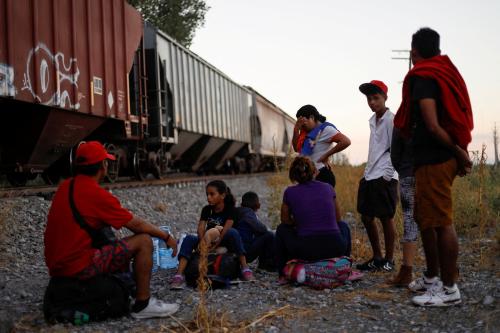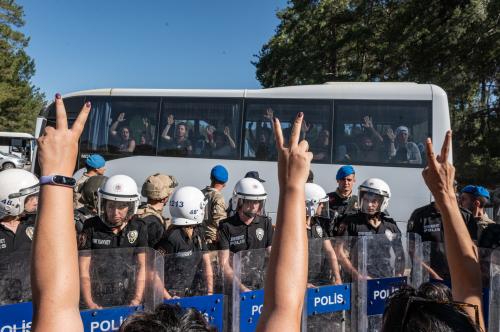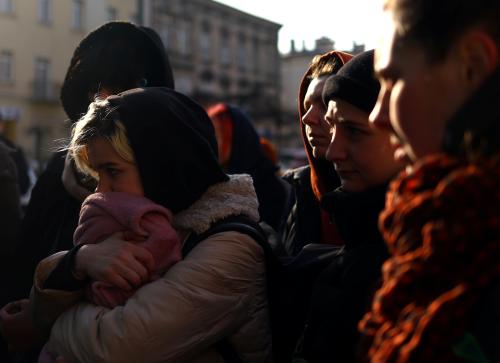The tragic earthquake in Haiti has shown us the immense forces of nature to which mankind is exposed. The international community reacted swiftly and comprehensively to this crisis. I was—and still am—particularly impressed by the response of the people of Haiti and its solidarity with the victims of the disaster. Most Haitians suffered from this tragedy in one way or another. They deplore family members who were killed or hurt, lost jobs or livelihoods, or had their houses and properties destroyed or damaged. And yet the people showed an amazing generosity with those who were even more affected than themselves. A large number of the displaced have found refuge with and have been given support by host families and host communities within and outside of Port-au-Prince.
Today, seven weeks after the disaster struck, the emergency phase, which focused on life saving activities, has come to a close. Even if humanitarian needs remain significant and require the on-going attention of the humanitarian actors, in particular in terms of shelter and sanitation, our focus must now shift toward the recovery and rebuilding of Haiti. The internally displaced persons in Haiti must be provided with the means to rebuild their existence and to resume their life. They must be able to find a durable solution to their displacement. The road toward durable solutions is long and arduous. The full commitment of the international community is needed to support and facilitate the tasks of the national and local authorities in Haiti, which have the primary responsibility to create conditions conducive to durable solutions.
Finding durable solutions for internally displaced persons is never easy. It is a gradual and long term process, during which human rights, humanitarian, development and reconstruction challenges need to be addressed. It also requires the close coordination and co-operation of national and local authorities, humanitarian and development actors. I have seen situations where the displaced continue to live in rundown camps or collective shelters years after a natural disaster has struck because the political will or the capacity to reintegrate them into society is lacking. I have visited places where the displaced were not able to return to their homes because of unresolved property disputes. I have met with displaced persons, whose initial hope after a disaster has given way to frustration about unmet expectations and desperation about the lack of perspective due to lack of access to livelihoods. And I have come across far too many displaced persons who were not able to fully enjoy their human rights and faced discrimination and marginalization and yet officials called the recovery process a success.
Together with humanitarian and development actors I developed a Framework for Durable Solutions, which gives guidance for a rights-based approach to durable solutions to the displacement of persons who were forced to flee or leave their homes but remained within their own country. The Framework identifies key elements and good practices regarding the process that should be followed and sets benchmarks against which the achievement of durable solutions can be measured. Based on the experiences from many countries affected by internal displacement, the Framework stresses that more than return and reconstruction of houses is needed to make solutions durable: Rather, durable solutions are only achieved once all rights affected by the displacement are restored and affected persons no longer have displacement-specific needs, i.e. needs they would not have had they not been displaced. The Framework was endorsed by the Inter-Agency Standing Committee and forms an annex to my annual report to the Human Rights Council.[1] Let me briefly illustrate how the Framework and its elements can be of use in Haiti in preparing for and implementing recovery measures that lead to durable solutions.
- Informed choice on whether or not to return
The Framework clearly states that durable solutions can be achieved through sustainable integration at the place of origin (return), at the location where affected persons were displaced to (local integration), or at a location in another part of the country (settlement elsewhere in the country). It stresses the right of internally displaced persons to choose between these solutions on the basis of sufficient information as well as the right to be consulted on and participate in the planning of durable solutions. In the context of Haiti, this means that early recovery and recovery programs should not only respect these rights but build on them. Thus, recovery programs should not only be designed for the areas which have suffered destruction in order to promote return of the displaced, but also for host communities in order to allow for local integration of those among the displaced who opt for this solution.
- Long term safety and security
IDPs must enjoy physical safety and security. In the case of Haiti this means that Disaster Risk Reduction measures—to reduce seismic risks as well as flooding and mudslide risks linked to environmental degradation—have to be an integral part of the reconstruction process. The focus should be on helping IDPs who want to return to build back better, so that their houses and public infrastructure can withstand future seismic or meteorological disasters. Relocations to other parts of the country should only be considered as a last resort, and to the extent that safe return or local integration at the location they fled to is impossible, because these locations would remain unsafe and life threatening even if reasonable disaster risk reduction measures are taken. Relocations without the consent of those affected have to be based on a law, planned on the basis of an expert assessment and conducted with due information and participation of the affected persons in a non-discriminatory manner taking special measures to protect the most vulnerable and are only permissible if they are the only possibility to protect people against a real risk of serious harm to life and limb.
Finally, the duty of the government to protect its population, including the displaced, requires strengthening the police and legal structures as part of the recovery efforts in order to be able to provide security and access to legal protection mechanisms.
- Enjoyment of an adequate standard of living without discrimination
IDPs in Haiti must have adequate access to essential food and potable water, basic shelter and housing, essential medical services, sanitation and at least primary school education not only during displacement but also in the areas where they can find a durable solution for them. In this context, it is essential for donors to fund programs to support small scale farmers and restore food security.
- Access to livelihoods and employment
Securing livelihoods and employment opportunities in the long run will be a significant challenge in the recovery process given the widespread poverty and the lack of employment opportunities before the earthquake. In the short term, the cash for work programs run by UNDP and many other organizations are an important opportunity for Haiti’s displaced to take their life into their own hands and to avoid an aid dependency syndrome. The enormous needs for reconstruction also offer employment opportunities, which could be linked with appropriate training programs. More thinking has to go into involving women into such programs and create livelihood opportunities for persons with disabilities
- Effective and accessible mechanism to restore housing, land and property
Haiti doesn’t have a reliable property register and many documents were destroyed in the earthquake. It has to be ensured that IDPs who want to return can regain physical possession of the housing and land they left behind. At the same time, an effective mechanism to settle property disputes should be created as regular courts my not be in a position to handle a great number of cases, and alternative proofs of property and ownership in the absence of formal titles should be admitted.
- Access to personal documentation without discrimination
Many people lost their personal documentation, which causes a number of very practical problems, e.g. international money transfers cannot be picked up without an ID card. An expedient procedure to issue personal documentation needs to be set up, which will also be important for the next elections. The absence of death certificates could also raise questions regarding pension or inheritances, which have to be carefully analyzed.
The list of tasks is long and overwhelming. What is urgently needed is a well-planned recovery strategy, a ROADMAP to rebuild the lives of Haiti’s IDPs that uses a human rights-based approach. It will be important to ensure a participation of the IDPs in the planning and the management of early recovery, recovery and development strategies and I encourage intensive consultation with the persons affected and displaced both in and outside of Port-au Prince in the preparation of the Post Disaster Needs Assessment. In order to make the solutions truly durable it will also be important that IDPs can make a voluntary and informed choice on where to rebuild their lives, whether their former place of residence or at another location in Haiti.
I am confident that the Post Disaster Needs Assessment will give answers to many of these questions and will provide a solid basis for the development of a strategy for durable solutions. The respect of the human rights of those affected by the disaster must be an integral part of this strategy. I also call upon all actors remain fully engaged in this process. The victims of the earthquake deserve no less than that.
[1] Framework on Durable Solutions for Internally Displaced Persons, A/HRC/13/21/Add.4.



Commentary
Next Steps for Haiti: Rebuilding the Lives of Haiti’s Internally Displaced Persons
March 8, 2010